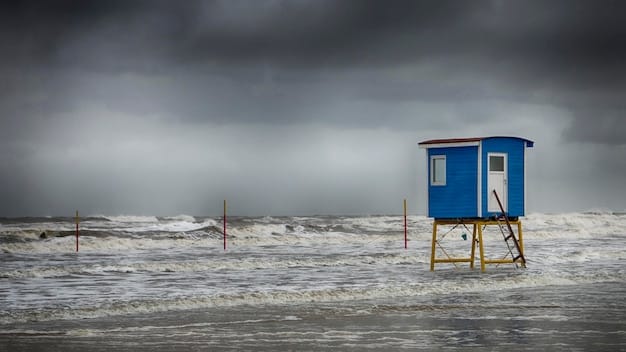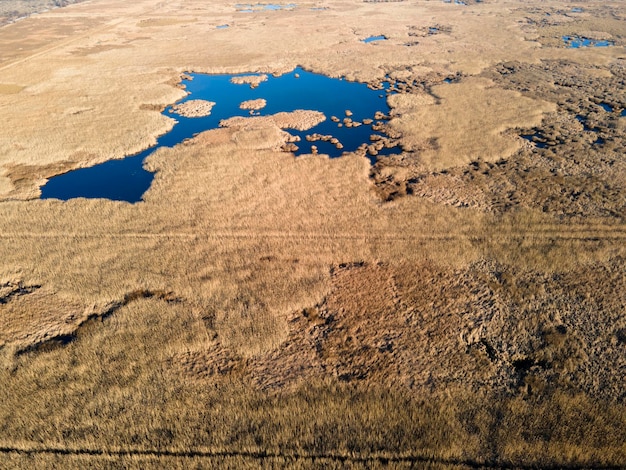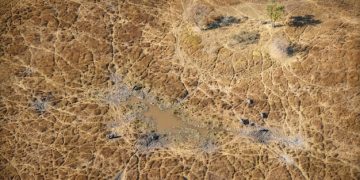Climate Change & US National Security: A Deep Dive

Examining the Impact of Climate Change on US National Security Strategy reveals a multifaceted threat, exacerbating existing risks, straining resources, and demanding a strategic recalibration to safeguard US interests and global stability.
The intensifying effects of climate change present a formidable challenge to nations worldwide, and the United States is no exception. Examining the Impact of Climate Change on US National Security Strategy requires a comprehensive understanding of how environmental shifts can destabilize regions, strain resources, and ultimately threaten American interests both at home and abroad.
Understanding Climate Change as a Security Threat
Climate change is no longer just an environmental concern; it’s a pressing security issue. Its effects are far-reaching, impacting everything from resource availability to migration patterns, creating fertile ground for conflict and instability. For the US, this translates into direct threats to its national security interests.
The Direct Impacts of Extreme Weather
Extreme weather events are becoming more frequent and intense, posing significant risks to US military installations and operations. Increased flooding, wildfires, and hurricanes can disrupt supply chains and strain already limited resources.
Resource Scarcity and Conflict
Climate change is a threat multiplier, exacerbating existing tensions over scarce resources like water and arable land. This can lead to conflicts, particularly in regions already prone to instability, potentially drawing in the US.
- Increased competition for water resources in arid regions may fuel cross-border conflicts.
- Sea-level rise can displace populations, leading to mass migrations and potential humanitarian crises.
- Changes in agricultural productivity can lead to food shortages and economic hardship, destabilizing governments.
In essence, climate change threatens to overwhelm existing security frameworks, demanding new strategies and approaches. Recognizing this is the first step in mitigating its potential impact on US national security.

The Pentagon’s Perspective on Climate Change
The US Department of Defense (DoD) recognizes climate change as a significant threat. The Pentagon has been actively studying the impacts of climate change on its operations, infrastructure, and overall readiness. This awareness is translating into concrete strategies to adapt to and mitigate these risks.
Adapting Military Infrastructure
Many US military bases are located in areas vulnerable to climate change, such as coastal regions susceptible to sea-level rise and increased storm surge. The DoD is investing in infrastructure upgrades to protect these assets.
Integrating Climate Considerations Into Planning
The Pentagon is incorporating climate change projections into its strategic planning processes, considering the potential impacts of climate change on future military operations and resource allocation.
- Assessing vulnerabilities of key military installations to extreme weather events.
- Developing strategies to maintain operational readiness in a changing climate.
- Investing in new technologies and capabilities to address climate-related security threats.
The growing recognition within the Pentagon signals a shift towards a more proactive approach, acknowledging that climate change is not just an environmental issue, but a fundamental challenge to US military strength and global power projection.
Climate Change and Global Instability
Climate change is a major driver of global instability. Its impacts are felt disproportionately in vulnerable regions, exacerbating existing socioeconomic challenges and creating new security risks. The US must understand and address these interconnected issues to safeguard its interests.
Climate Refugees and Mass Migration
Rising sea levels, desertification, and extreme weather events are displacing populations around the world, creating climate refugees and contributing to mass migration flows. This can strain resources and destabilize already fragile regions.
Increased Humanitarian Crises
Climate change increases the frequency and intensity of natural disasters, leading to humanitarian crises that require international assistance. The US is often called upon to provide aid in these situations, straining its resources and potentially diverting attention from other security priorities.

By acknowledging the link between climate change and global instability, the US can develop more effective strategies to promote stability and prevent conflicts before they escalate. Investing in resilience-building measures in vulnerable regions can help mitigate the impacts of climate change and reduce the likelihood of humanitarian crises.
Economic Implications for US National Security
The economic consequences of climate change pose significant challenges to US national security. Disruptions to global supply chains, increased disaster relief costs, and the need for infrastructure investments to adapt to climate change can all strain the US economy, impacting its ability to project power and influence abroad.
Supply Chain Disruptions
Extreme weather events can disrupt global supply chains, impacting the availability and cost of goods and services. This can have cascading effects on the US economy, particularly for industries that rely on imported materials or components.
Increased Disaster Relief Costs
The increasing frequency and intensity of natural disasters are driving up disaster relief costs, placing a strain on federal and state budgets. This can divert resources from other important priorities, such as national defense and infrastructure development.
- Investing in resilient infrastructure to reduce the impact of climate change on the US economy.
- Developing strategies to diversify supply chains and reduce reliance on vulnerable regions.
- Promoting international cooperation to address climate change and mitigate its economic impacts.
The economic challenges of climate change demand a comprehensive approach that integrates climate considerations into economic planning and policymaking. By addressing these challenges proactively, the US can strengthen its economic resilience and maintain its long-term national security.
The Role of Technology and Innovation
Technology and innovation are essential tools for addressing the climate change challenge and safeguarding US national security. From developing clean energy technologies to enhancing climate monitoring capabilities, advances in technology can help mitigate the impacts of climate change and strengthen US resilience.
Clean Energy Technologies
Investing in clean energy technologies is crucial for reducing greenhouse gas emissions and transitioning to a more sustainable economy. This can also enhance US energy independence and reduce its reliance on foreign sources of energy.
Climate Monitoring and Prediction
Advanced climate monitoring and prediction capabilities are essential for understanding the impacts of climate change and developing effective adaptation strategies. This requires investing in satellite technology, data analysis, and climate modeling.
By embracing technology and innovation, the US can lead the world in developing solutions to the climate change challenge and ensure its long-term national security.
Policy Recommendations for a Climate-Resilient National Security Strategy
Developing a climate-resilient national security strategy requires a multi-faceted approach that integrates climate change considerations into all aspects of US foreign and domestic policy. This includes setting ambitious emissions reduction targets, investing in resilience-building measures, and promoting international cooperation.
Setting Ambitious Emissions Reduction Targets
The US must commit to ambitious emissions reduction targets to limit the impacts of climate change and demonstrate global leadership. This requires transitioning to a clean energy economy, phasing out fossil fuels, and investing in sustainable transportation systems.
Investing in Resilience-Building Measures
The US must invest in resilience-building measures to protect its infrastructure, communities, and military installations from the impacts of climate change. This includes upgrading infrastructure to withstand extreme weather events, developing drought-resistant crops, and restoring coastal wetlands.
- Strengthening international partnerships to address climate change.
- Integrating climate considerations into all aspects of US foreign policy.
- Supporting developing countries in their efforts to adapt to climate change.
By adopting these policy recommendations, the US can build a more climate-resilient national security strategy that protects its interests and promotes global stability.
| Key Aspect | Brief Description |
|---|---|
| 🌍 Global Instability | Climate change exacerbates resource scarcity, leading to conflicts and mass migrations. |
| 🛡️ Pentagon’s Role | The DoD is adapting infrastructure and integrating climate data into strategic planning. |
| 💸 Economic Impact | Climate change disrupts supply chains and increases disaster relief costs. |
| 💡 Technology | Clean energy and advanced monitoring are vital tools. |
Frequently Asked Questions
▼
Climate change impacts military readiness by damaging infrastructure, disrupting supply chains, and increasing the demand for disaster relief efforts. Extreme weather events strain resources and can divert them from critical training exercises.
▼
Climate refugees are people displaced by climate change-related disasters like sea-level rise or droughts. Large-scale displacement can destabilize regions, creating humanitarian crises and potentially fueling conflicts over resources.
▼
Investments are needed in resilient infrastructure, clean energy technologies, and climate monitoring systems. Upgrading infrastructure can help withstand extreme weather, while clean energy reduces emissions and improves energy independence.
▼
International cooperation is vital as climate change is a global issue. Sharing knowledge, resources, and coordinating policies can amplify efforts in mitigating climate impacts and promoting stability worldwide.
▼
Technology offers solutions like clean energy, climate monitoring, and resilient infrastructure materials. Innovations can help the US both reduce its carbon footprint and better adapt to the unavoidable effects of climate change.
Conclusion
Addressing the impact of climate change on US National Security Strategy is a complex but crucial undertaking. By acknowledging the multifaceted threats posed by climate change, investing in resilience-building measures, and promoting international cooperation, the US can safeguard its interests and contribute to a more stable and sustainable future. The challenge requires proactive and comprehensive planning, integrating climate considerations into all aspects of national security policy.





